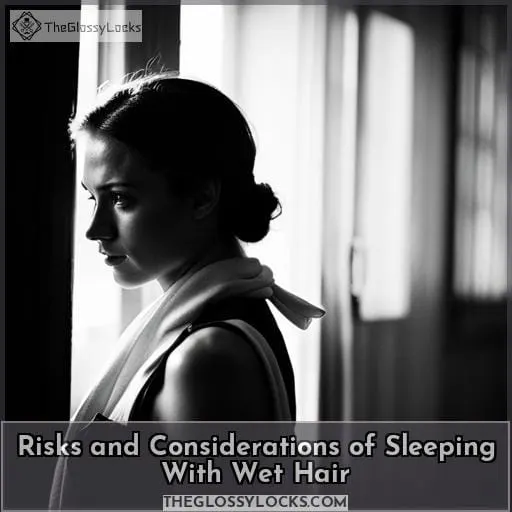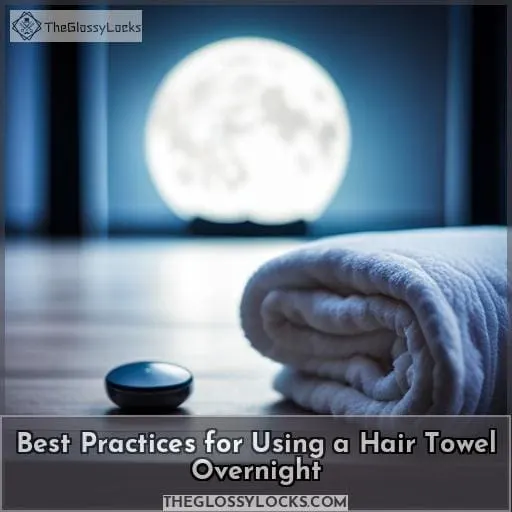This site is supported by our readers. We may earn a commission, at no cost to you, if you purchase through links.

Leaving your hair in a towel overnight is becoming increasingly popular for its many benefits including avoiding damp strands on the pillow and preventing damage from friction.
Can I Leave My Hair In A Towel Overnight? If so, what are some tips for making sure it doesn’t harm my locks? Learn all about sleeping with wet hair here and find out if this method could work wonders for you.
Table Of Contents
Key Takeaways
- Leaving your hair in a towel overnight can prevent damp strands on the pillow and protect the cuticle layer for improved hair health.
- Using a leave-in conditioner before tying your hair into a high bun can protect against breakage and frizz.
- Using microfiber towels, oil-free moisturizers, and scarves can promote natural curls and protect against breakage and frizz.
- Consider using silk pillowcases, silk scarves, or satin pillowcases to minimize friction, distribute oils, reduce frizz, and protect your hair while you sleep.
Benefits of Sleeping With a Hair Towel
You may be wondering if it’s okay to leave your wet hair in a towel overnight. Doing so can help avoid damp strands on your pillow, prevent moldy pillows from forming, and reduce friction that leads to damage.
Stylish hair towels not only absorb moisture but also protect the cuticle layer for healthier hair over time, as well as preventing brittle locks when you wake up in the morning. Leaving wet hair before bedtime can even aid in preventing colds by avoiding any potential chilling effects of dampness.
Avoiding Damp Strands on Your Pillow
To avoid waking up with damp strands on your pillow, consider styling your hair before bed and wrapping it in a stylish towel that can absorb moisture. A hair turban or towel helps prevent friction between the fabric and wet locks while protecting against moldy pillows during sleep.
Innovative designs are also available to protect the cuticle layer for healthier hair over time.
For extra protection from breakage or frizz, apply leave-in conditioner before tying your hair into a high bun with an appropriate scrunchie.
Upgrade your routine by choosing microfiber towels paired with oil-free moisturizers, as well as bandanas and scarves.
Preventing Moldy Pillows and Reducing Hair Damage
By using a hair towel, you can prevent moldy pillows and drastically reduce the risk of damaging your precious locks – making it worth every last penny!
Pillowcase choices such as silk or satin are ideal for reducing friction to maintain hair health. Alternatives like microfiber towels and innovative wraps protect the cuticle layer while preventing frizz.
Overnight care includes partially drying before sleep, applying leave-in conditioner, securing with a scrunchie, bandana, or scarf—especially helpful for curly hair—and evenly distributing cream with a comb to promote natural curls.
To ensure optimal results, avoid leaving wet strands in the towel overnight; instead, opt for a gentle squeeze and suitable alternatives like silk pillowcases.
Protecting the Cuticle Layer and Promoting Healthier Hair
Using a hair towel can help protect your hair’s cuticle layer and promote healthier strands over time. The innovative design of modern wraps helps reduce friction, preventing damage to the vulnerable surface of each strand.
Silk towels absorb moisture quickly while providing necessary nourishment overnight for enhanced softness and shine in the morning.
Furthermore, they minimize dampness effects that could lead to frizz or split ends due to excess exposure and prevent oil transfer from the scalp onto the face during sleep for better skincare results overall.
Absorbing Moisture and Preventing Brittle Hair
Wrapping your wet locks in a hair towel helps absorb extra moisture, securing soft strands and preventing brittle breakage. Plus, it prevents odors from lingering on the pillow while providing overnight hydration to keep elasticity intact.
The right material can also aid morning styling by minimizing frizz for effortless looks. Hair care tips like this can help prevent damage and maintain healthy tresses over time – just remember to change towels regularly! With proper technique and maintenance, you’ll be able to enjoy shiny results day after day with minimal hassle.
Aiding in Preventing Colds by Avoiding Damp Hair
Protect yourself from a chill during the night by drying your hair before bed. Utilize proper hair care and drying techniques to help reduce colds caused by damp hair.
- Air dry or use a low setting on your hairdryer to partially dry wet strands.
- Apply leave-in conditioners for protection against breakage and frizz.
- Create an updo with a scrunchie to avoid discomfort while sleeping.
- Wrap in a microfiber towel, especially when using styling creams for textured locks. Secure with a silk scarf or bandana afterwards for added frizz reduction benefits.
Furthermore, opt for silk pillowcases as they minimize damage and evenly distribute oils across the scalp, aiding healthier-looking locks!
Risks and Considerations of Sleeping With Wet Hair
When sleeping with wet hair, you should be aware of the risks associated with this practice. There is an increased risk of fungal infections and dermatitis due to the warm and damp environment created by leaving your hair in a towel overnight.
It is also important to keep pillows and bedsheets dry, minimize friction to maintain volume and shine, and prevent excess oil transfer onto your face. With these considerations in mind, it is essential that you take care when using a hair towel before sleep.
Increased Risk of Fungal Infections and Dermatitis
If you’re not careful, sleeping with wet hair could put your scalp at risk of developing fungal infections and dermatitis. To avoid this, it’s best to use a towel that absorbs moisture while protecting the cuticle layer.
Opt for microfiber fabric or bamboo material for added hydration and texture-enhancement benefits.
A leave-in conditioner can also help prevent breakage and frizz overnight while ensuring healthy hair by morning. Further prevention includes changing pillowcases frequently to reduce friction from dampness.
Finally, opt for a silk scarf or bandana over regular cotton fabrics when styling before bedtime. These materials will help retain moisture but still keep strands safe from damage due to prolonged exposure.
Importance of Keeping Pillows and Bedsheets Dry
It’s important to keep your pillows and bed sheets dry when leaving wet hair in a towel overnight – mold growth could be an issue! To ensure sleep comfort, it is recommended that you choose pillow protection such as silk pillowcases and moisture-wicking materials.
Additionally, controlling fungal growth on the bed by regularly washing sheets with antibacterial detergents can help maintain hygiene.
Minimizing Friction and Maintaining Hair Volume and Shine
Wrapping your locks in a hair towel helps reduce friction and preserve your hairstyle, giving you smooth and glossy tresses all day long. Air drying is best for thin or fine hair, while those with thicker textures should use low heat settings on the hairdryer.
A silk scarf will also help further minimize frizz, tangles, and breakage as it preserves moisture within the cuticles of each strand. Hair treatments, such as leave-in conditioners, are also beneficial to enhance shine and protect against damage when air drying or styling with hot tools.
For an added layer of protection from daily friction during sleep, opt for a silk pillowcase that evenly distributes natural oils throughout to ensure healthier strands over time!
Preventing Excess Oil Transfer to the Face
By using a hair towel, you can help protect your skin from transferring excess oils onto your face. When drying wet hair, leave-in conditioner helps prevent frizz and breakage. Drying time should be kept to a minimum as excessive exposure may damage the cuticle layer of the strands or lead to acne breakouts due to facial oil transfer.
Innovative wraps offer protection while distributing natural oils for healthier looking locks with less friction and dryness on the scalp – all without sacrificing style! To further reduce facial oiliness, opt for an absorbent microfiber material that traps moisture rather than letting it escape into pillows or bedsheets.
Utilize these methods in tandem with other hair care tactics such as silk pillowcases or scarves for optimal skincare results at night!
Best Practices for Using a Hair Towel Overnight
It is important to understand the best practices for using a hair towel overnight if you are looking to preserve your hairstyle and promote healthier hair. Partially drying your hair before sleep helps reduce friction that leads to damage, while applying leave-in conditioner provides protection against breakage and frizz.
Securing your strands in a high bun with a scrunchie can also help avoid discomfort during sleep, as well as reducing frizz by wrapping them up with a silk scarf or bandana.
Partially Drying Hair Before Sleeping
Partially drying your locks before bed is key to protecting them from potential breakage and frizz. Air-drying helps preserve the cuticle layer, while using a leave-in conditioner provides extra protection.
To reduce friction and tangles, tying hair into a high bun with a scrunchie or securing it with a silk scarf are recommended techniques.
For added benefits, use an innovative hair wrap design such as microfiber towels that help absorb moisture without damaging the strands or spread natural oils for healthier hair over time.
Applying Leave-in Conditioner for Protection
To protect your locks from damage overnight, applying a leave-in conditioner is an absolute must! Leave-in conditioners offer numerous benefits, protecting your hair against breakage and frizz while locking in moisture.
To get the most out of it, use one that’s specifically formulated for nighttime wear.
For those with curly or textured hair, opt for creams instead of sprays to ensure better coverage and lasting hydration. When using any type of conditioning product before bedtime, remember to evenly distribute it throughout damp strands with a comb or brush before styling.
Tying Hair Into a High Bun With a Scrunchie
Tying your mane into a high bun with a scrunchie helps you avoid discomfort while you sleep and keeps your hairstyle looking great. Scrunchies come in various materials such as silk, cotton, or even velvet to suit different hair types and styles.
Not only does it protect against friction that causes breakage, but it also locks in moisture for added shine and volume.
A bun is better than leaving loose strands, which can cause tangles overnight, leading to morning frustration! Plus, the tight fit of the scrunchie prevents oil transfer from the face throughout the night, providing an extra layer of skincare benefit too!
It’s important to remember that not all scrunchies are created equal. Pick one tailored specifically for long-term use that won’t leave any creases on your scalp when sleeping.
Reducing Frizz With a Silk Scarf or Bandana
Adding a touch of style to your nightly hair care routine can be as simple as securing it with a silk scarf or bandana. These offer numerous benefits, such as preventing frizz and protecting the cuticle layer from damage.
You have many choices for hair accessories: Microfiber towels are great for creating texture, while bamboo is best for avoiding static cling. Satin is ideal if you want softness and shine, while silk offers maximum protection against breakage and split ends.
Myths and Facts About Sleeping With Wet Hair
It’s often said that sleeping with wet hair can cause a cold, but this is nothing more than an urban myth. To ensure the health of your hair and scalp, it is recommended to utilize satin pillowcases for faster drying and protection while avoiding damage from prolonged exposure to moisture in towels.
Debunking the Myth of Causing a Cold
Despite a common myth, sleeping with wet hair doesn’t directly cause a cold. Just like wearing an extra layer of clothing won’t necessarily keep you warm. In reality, the immune system plays a much larger role in detecting and fighting off viruses that could lead to illness.
Medical professionals often advise minimizing dampness on the scalp as excessive moisture can lead to skin irritation or infection. Hair health also benefits from avoiding excess contact with water. Frequent towel drying sessions can help reduce damage caused by friction or tangling.
It’s important to note that everyone has different needs when it comes to hair care.
Utilizing Satin Pillowcases for Faster Drying and Protection
Upgrade your sleep experience by switching to a satin pillowcase; you’ll enjoy faster drying and enhanced protection for your hair. Satin pillowcases provide superior benefits compared to other materials, allowing air circulation without creating static electricity or friction.
This leads to quicker evaporation, resulting in less damage caused by leaving wet hair overnight.
Additionally, the smooth texture of a satin pillowcase prevents tangles and helps retain moisture better than silk options. It also protects cuticles from breakage due to dryness or heat exposure during styling sessions.
For optimal results when using a satin pillowcase, we recommend selecting high-quality products with at least 400 thread count.
Avoiding Hair Damage and Bacterial Growth
To prevent hair damage and bacterial growth, opt for a gentle towel squeeze and secure your locks with a soft scrunchie. Change your pillowcase to minimize friction, tangling, and odor buildup. Hair wraps provide an alternative to towels, while overnight hair care products like conditioners can help protect against breakage.
Towel hygiene is key; replace yours regularly or try microfiber fabric options that absorb moisture quickly but remain gentle on the scalp.
Contact for Further Guidance on Hair Wraps
For personalized advice on the perfect hair wrap for your routine, don’t hesitate to reach out and get expert guidance! Hair wraps can offer numerous benefits such as protection from frizz, boosting volume and shine, preventing moisture transfer to the skin, and even preserving hairstyles.
Choose suitable wraps that match your hair type. Microfiber works best for textured styles, while satin is beneficial for straight strands. When styling with a wrap at night, opt for leave-in conditioners or creams that provide extra nourishment while you sleep.
For different types of hair, consider nighttime care like tying it into a high bun or using silk pillowcases.
Enhance your haircare routine by turning to experts who understand all aspects of this important topic. They can help you create the right environment with humidity control products or find an innovative design that promotes healthier locks over time.
Upgrade Your Hair Care Routine
Upgrading your hair care routine is key to keeping your locks looking healthy and shiny. A great way to start is by incorporating suitable hair wraps into the equation. Silk scarves, bandanas, and microfiber towels are all excellent choices for wrapping wet hair overnight.
These materials help reduce friction while promoting natural shine even after sleeping with wet strands.
Additionally, they can help evenly distribute any leave-in conditioners or styling creams you use for textured styles without causing damage or breakage from tangles and knots in the morning! As an added bonus, a silk pillowcase can also provide protection against frizziness while helping speed up drying time as well.
With these tips in mind, you’ll be sure to keep your hairstyle intact throughout each day!
Conclusion
It’s important to understand the potential benefits and risks associated with leaving hair in a towel overnight. Surprisingly, up to 80% of people do this, which can increase the risk of fungal infections and dermatitis due to the warm and damp environment created.
However, with the right practices, you can maximize the benefits of using a hair towel. It can reduce friction that leads to hair damage, protect the cuticle layer, and help preserve your hairstyle.
To ensure your hair stays healthy, there are a few things you can do. First, try using a leave-in conditioner before wrapping your hair in a towel.
Next, consider tying your hair into a high bun. This will help keep your hair secure and prevent it from getting tangled or damaged while you sleep.
Lastly, opt for a silk pillowcase. Unlike cotton, silk is gentler on your hair and reduces friction, which can help prevent breakage and frizz.
By following these tips and incorporating them into your hair care routine, you can safely use a hair towel overnight without damaging your locks.









